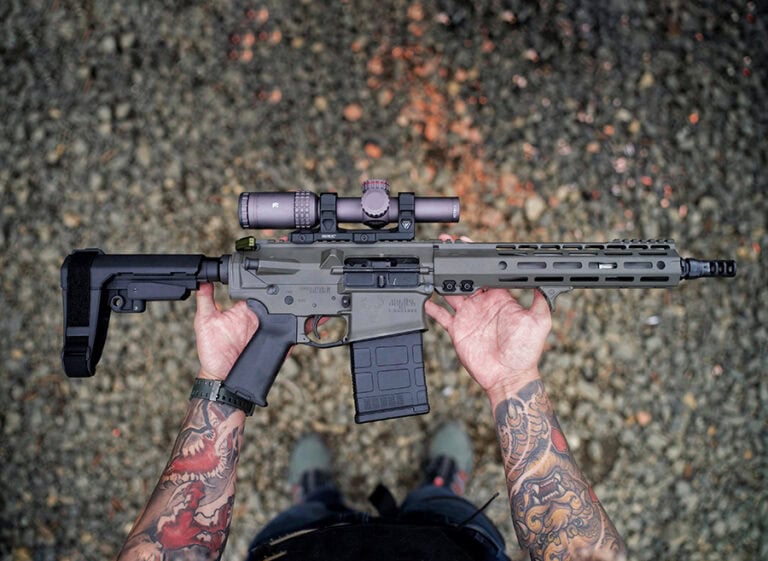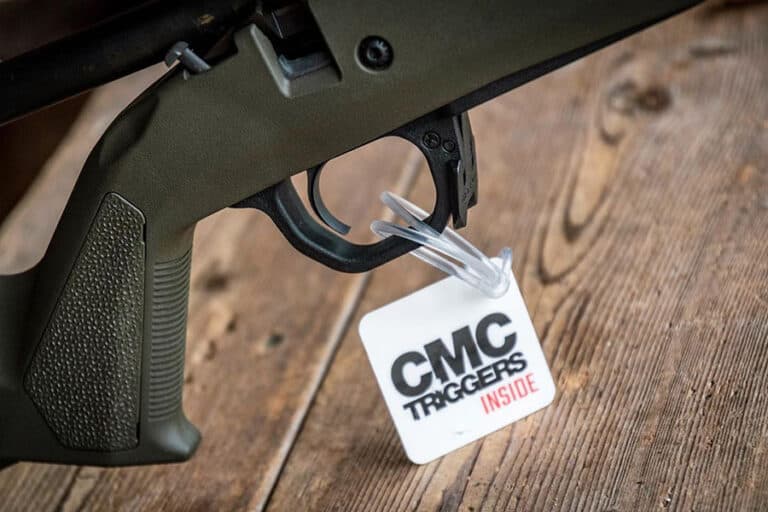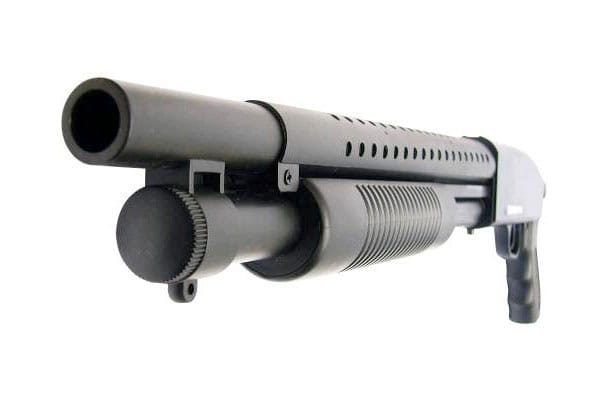TAG Precision—American-made RMR Plate for Kimber
For users of optics-ready Kimber 1911 and 2K11 pistols, TAG Precision has announced…
For users of optics-ready Kimber 1911 and 2K11 pistols, TAG Precision has announced…
Fountain Valley, CA—SureFire, LLC, manufacturer of the world’s finest—and most innovative—illumination tools and…
Shinenyx—creators of a cutting-edge fusion of digital night vision and thermal imaging technology—has…
The Mod-Navy Qual I’ve been doing this qual (or drill, or whatever the current nom…
• Built for road trips and off-road use• Manual transmission equipped• Wrapped in MultiCam Arctic…
I designed the Button Man to give shooters a low-round-count, low-light-engagement drill that involved both…
As a former SWCC operator a long time ago in a lifetime far, far away, I had the privilege to use whatever the Naval Special Warfare armory had to offer. When it came to personal long guns and side arms that was left up to the operator. If I wanted something between a long gun or pistol, I would rock the HK MP5N or MP5SD. The UMP45 was still under development and not available at the time and the MP7 was still a weapon of the future which makes me sad… I’ll get over it. Anyway, the MP5 bridged the gap between a semi-auto hand gun caliber and the larger caliber rifle round. On the small boats, space is limited so its small size and high rate of fire made it a valuable asset. To this day, the MP5 is still one of my favorite firearms that I have ever shot.
"If I wanted something between a long gun or pistol, I would rock the HK MP5N or MP5SD."
During my Navy days in the late 90s the transition from sub gun to the larger Colt M4 was well underway. Most of the SEAL Teams I worked with were using M4s, but every now and then they would use their German subguns. The MP5 did have a few limitations. Mainly, it is a submachine gun, meaning even though it is a select fire weapon and can put 9mm on target at 800 rounds per minute, it still lacked the velocity and energy distribution of a rifle.
In order to bridge the gap between the sub gun and the rifle, a new class of firearm was born. Known as the Personal Defense Weapon, or PDW, it is a small, compact firearm, like a sub gun, but fired a higher velocity round that was theoretically capable of penetrating body armor. The PDW continues to mature into the present day. Many PDWs come in calibers that are proprietary to that specific firearm or family of firearms. Examples would include the FNH P90 (FN 5.7x28mm), the HK MP7 (4.6x30mm) and the KAC PDW (6x35mm). Regardless of their performance (or lack-there-of) those rounds are very specific, not very plentiful (especially on the battle field) and potentially unavailable, or cost prohibitive to the civilian shooter or Law Enforcement Officer.
The PDW concept has evolved into more common calibers that we are used to seeing such as 5.56 NATO and .300 Blackout. It is also becoming a popular item for shooters of the AR15 type rifle and SHOT Show 2016 was evidence that the popularity is growing. You can find a variety of companies offering ultra-short AR15 SBRs that are now being classified or branded as PDWs.
"The PDW concept has evolved into more common calibers that we are used to seeing such as 5.56 NATO and .300 Blackout."
So how do you take an operating system that has been around for over half a century and make it more compact while maintaining the ability to shoot the same sized round? The simple answer is to shorten the barrel. That will make the firearm more compact, however it will cause other issues with the AR platform that is better suited for another article. OK, what next? The next thing to reduce is the stock. Easy, right? Well, not really. The AR needs an extension tube, buffer and spring to work that is dependent on the length of a standard bolt carrier group. Telescoping stocks have been developed, with shorter extension tubes, buffers have been redesigned and springs revised in order to make a more compact firearm. This has been largely successful and is a common sight on today’s modern battlefield as wells as at every rifle range across the good ol’ US of A.
In order to make the AR even more compact, more stock design is needed. One redesigned style of compact stock would become known as the PDW stock and it does come in a variety of shapes and sizes for multiple styles of firearms. Troy Industries is one of many manufacturers who have taken the AR15/AR10 compact stock concept and reduced the size even further than the traditional telescoping stock.
"Troy Industries… have taken the AR15/AR10 compact stock concept and reduced the size even further"
Their first rendition of the PDW stock is called the M7A1. It utilizes a simplified stock attached to rods that slide around a compact extension tube, with modified recoil system. At SHOT Show 2016 Troy introduced the next generation of PDW stock which they call the Tomahawk.
The Tomahawk takes the design of their M7A1 and develops it a bit further. The Tomahawk features the same light weight and compact features of the M7A1 and adds better ergonomics, weight savings and flexibility. The Tomahawk has a polymer stock with integrated cheek weld. One thing that suffers from most PDW stocks is comfort. While that is not their primary purpose, it is nice that Troy thought about incorporating better ergonomics into their design. The rails, latch and extension tube are made out of hardened air craft aluminum and features an integral QD attachment point at the rear of the stock.
The Tomahawk comes in two versions, for both 5.56 and .308 AR long guns in a variety of colors. The first model is a standard version that will accommodate a standard mil-spec bolt carrier group with an adapter and spring. This version reduces the stock length by 2 inches.
The second version is called the Short, which reduces the length by 3.4 inches as compared to a standard M4 stock. In order to do this Troy uses a proprietary bolt carrier that has a buffer pad integrated into the end of the carrier.


The Short PDW 5.56 stock is what I received for this review. The reason I opted for the Short is I wanted to evaluate how compact I could make my SBR. The stock came in a box, with instructions, the stock, spring, bolt carrier group, castle nut and end plate. Installation is pretty straight forward but make sure you read the instructions. Because it works with a proprietary system, it is a little different than installing a typical M4 style stock. One thing you will need to do is remove all the components of your old stock, should you be replacing it with the Troy PDW like I was. This includes the buffer retaining pin and spring. They are not needed and would most likely cause a malfunction if left in. I opted to use my own end plate with an integral QD point in the end as that is my preferred location for sling connection. I would later find that to be a waste of a part as there is not enough room to attach the QD stud thanks to the geometry of the PDW stock. The castle nut that is provided is recessed around the perimeter to allow the installer to stake the nut to the end plate which is recommended by Troy and this author.
Once the stock is installed onto the lower receiver the upper must be fitted with the BCG which installs just like a standard mil-spec unit. The difference is with the recoil (buffer) spring as there is no separate buffer. The spring is inserted into the shortened extension tube and then the other end is slipped over the proprietary bolt carrier. The two receiver halves are then pushed together and pinned in place. Once assembled, I found my SBR much lighter and way more compact when compared to its previous configuration.
"I found my SBR much lighter and way more compact when compared to its previous configuration."
The four position stock is easily retracted by using the shooting hand thumb to press up on the latch that is located under the extension tube. Due to the shortened length of pull, the stock really puts the shooters face at the charging handle and then some. The optic on this particular rifle is a Trijicon ACOG with an RMR on top. The ACOG as a very short eye relief, but in order for me to get the stock to work with the optic I had to move the optic forward on the upper receiver to prevent turning myself into a one eyed pirate. A single red dot optic, mounted forward wouldn’t be as much of an issue. Another thing I found with the reduction in stock length is that I had to make my 6’-1” frame really compact behind the rifle, which I suppose is a good thing in tight spaces, but not the most comfortable shooting position I have ever been in.
Function checking the weapon with the stock installed was very intuitive but there are a few things you should be aware of. If you use a battery assist device or enlarged bolt catch you may need to remove them and go back to the standard mil-spec versions. My particular SBR had a Phase5 EBRv2 attached which prevented the stock from closing all the way. Once removed and the standard unit re-installed the stock closed like it should. It should be noted the stock was installed on a mil-spec forged lower. I cannot comment on how it will work on a billet lower receiver. Many billet lowers have more material, ambi operating controls and aesthetic features that may prevent the Troy PDW stocks from working properly. Keep that in mind before purchasing.


At the range the rifle performed well. I did notice the recoil impulse felt a little sharper with the PDW stock installed. This is most likely due to the fact that the BCG is pulling double duty during recoil by also taking the responsibility as the buffer, meaning it is probably hitting the back of the extension tube during the firing cycle, increasing the felt recoil. Regardless, it wasn’t an issue, just something that was noticed. I shot it unsuppressed and suppressed using a CRUX Nomad 30 sound suppressor without issue. There were two light primer strikes throughout the initial 200 round initial evaluation. One round was refed and fired and the other refused to fire. Both rounds were .223 55gr remanufactured ammunition by Freedom Munitions. I would chalk this up to an ammunition issue. 62 gr M855 cycled well, without incident.
The rifle and stock got quite a bit of attention at the range. Some folks were perplexed as they couldn’t figure out how the stock worked from an operational standpoint. Once I explained it, they understood and thought it was pretty dang cool. I also had a motorcycle police officer get some time on the rifle and we compared it to the hard saddle bags on his motorcycle. The rifle appeared to fit with the stock collapsed. He was excited about this as he was looking to increase his capabilities, however was struggling to fit a standard AR15 with the limited space available on a motorcycle. Also, while the stock was very compact for me, it was less so for him as he was wearing his issued body armor. He felt a PDW type rifle would be a great addition for the motorcycle officers. I would agree.
"The rifle and stock got quite a bit of attention at the range."
Over all Troy accomplished what they set out to do. They designed an extremely compact stock that is extremely light weight and easy to deploy. I have very few criticisms, but there are a few things I would investigate. I would look at revising a few design features such as moving the release latch rearward just a tad to allow a QD stud to mount to the endplate. This would also allow for a slightly longer length of pull, a longer polymer check weld and potentially accommodate aftermarket battery assist devices and/or enhanced bolt catches. I’m talking maybe .125” or .25” of extra length. Just enough to eliminate the conflict between the stock and end plate sling attachment point. Another observation is the number of positions on the stock. It doesn’t need four. It only needs two. Collapsed and extended. The stock is so compact I can’t see any of the other positions being used even with the slightest adults. That being said, the third position worked well for my 9-year-old daughter so maybe that is justification enough.
If you are looking to make your registered SBR even more compact, think about installing a PDW stock. No, they aren’t for everyone or every application but they have their place and it’s always nice to have a little variety in the gun safe. Troy offers their standard PDW stock for $299.00 and their Short version for $399.00 (with proprietary BCG). Give them a moment of your time. The Troy PDW stock may be right for you.





* The views and opinions expressed on this web site are solely those of the original authors and contributors. These views and opinions do not necessarily represent those of Guns & Tactics Magazine,
the administrative staff, and/or any/all contributors to this site.
Steve is a former United States Naval Special Warfare Combat Crewman (SWCC), NRA Life Member and has been a firearms enthusiast for over 30 years. Steve is a writer and photographer focusing on the testing and evaluation of new products and has a natural gift for breaking things. He resides in the Pacific Northwest with his wife and children enjoying the shooting sports and the great outdoors.
Continued from A Sniper Rifle is Born in Russia – Part 1. When I was going to visit ORSIS, the media broadcast a program about an old Russian…

In this episode we are taking a look at my pandemic build #3. A short AR10, .308, fire breathing, concussion producing, range toy.

CMC Triggers, the original manufacturer of the AR Drop-in Trigger Group, today announced the official launch of the Remington 700 Ultra Precision Trigger.

Details are emerging from the recent NRA Annual Meeting that the NRA and the ATF have reached a deal regarding the ATF defining an owner of a pistol-grip…

The most important thing you can do is decide to start now. It’s not too late and everything you do today can be built on tomorrow.
[dcs_img_right framed=”black” w=”175″ h=”75″] http://gunsandtactics.wpengine.com/wp-content/uploads/2012/03/timoney-logo.gif [/dcs_img_right] Taiwan began fielding a replacement for its M-113 and V-150 armored personnel carriers in 2007, with the introduction of the CM-32 Yunpao,…
© 2025 UN12 Magazine
© 2025 UN12 Magazine
Wait! Don’t forget to